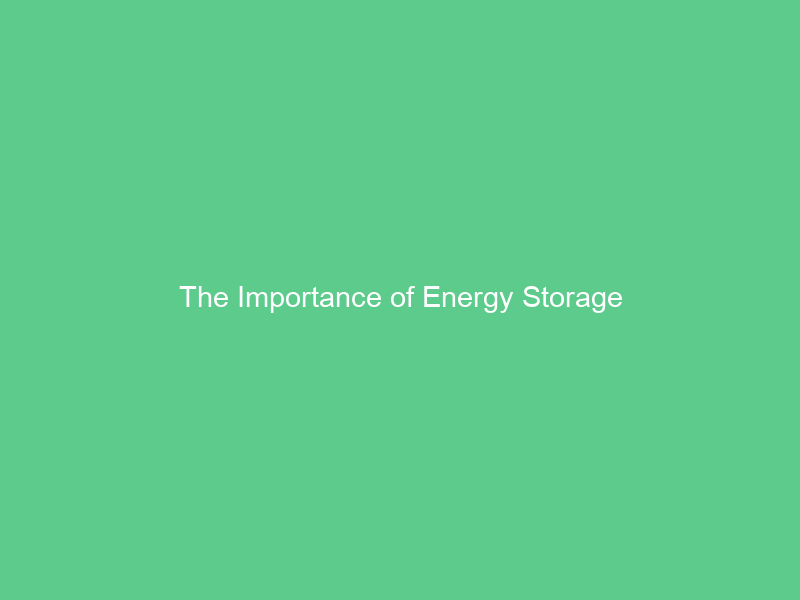Energy storage technology enables the capture and storage of energy for future use, helping balance electricity supply and demand, improve grid quality, and expand renewable sources of power.
Storage technologies available today include pumped hydro storage, lithium-ion batteries (LiFePO4) batteries (lithium-ion), flywheels, compressed air energy storage and thermal ice storage.
Electricity Storage for Community Resilience
States have come to realize the value of microgrids and resilience hubs as tools to strengthen electric grid resilience after Superstorm Sandy and other natural disasters, including battery storage support systems for these community microgrids and hubs. Battery storage bolsters these systems both locally by providing backup power supply as well as increasing flexibility of existing community solar or aggregated rooftop solar projects.
Energy storage is integral for integrating renewable sources like wind and solar into the grid, offering reliable sources of electricity during times of peak demand to prevent blackouts and reduce costs by shifting excess production during off-peak hours when prices are cheaper.
These benefits can help lower electricity bills for low-income households and communities of color who disproportionately bear the cost of fossil fuel power plants that produce air pollution and health impacts, though deployment costs remain prohibitive even as technologies become more accessible over time.
Electricity Storage for Rural Communities
Energy storage solutions are particularly essential in rural regions that face difficulties accessing reliable and affordable electricity supplies. Energy storage innovations offer reliable electricity supplies that drive economic development while improving lives across rural regions.
Farms and small to large scale industrial facilities rely on electricity to run machinery, irrigation systems and other operations. Integrating a BESS can reduce their reliance on the grid by optimizing energy use while simultaneously meeting environmental regulations for sustainable practices in business operations.
Energy storage systems can help households in rural communities save on electricity costs, especially those who rely on fossil fuels for power generation. Solar+storage solutions allow households to take advantage of renewable energy while avoiding sudden price spikes during peak demand periods. Some electric cooperatives even offer zero-percent financing options for battery devices placed directly in front of customers’ meters – known as customer energy storage (CES) systems – while at the utility scale batteries provide voltage support, frequency regulation, load leveling at substations and other related services.
Electricity Storage for Microgrids
Energy storage systems are key components of microgrids, providing peak shaving functionality and quickly switching between grid-connected and island mode operation. At NREL, they have created and tested a long-duration battery energy storage system (BESS) tailored specifically for microgrids containing three tiers of lithium-ion, nickel cadmium and lead acid batteries that provide the optimum combination of support functions for microgrid operation and grid stabilization functions.
Energy storage enables microgrids to meet their regulatory and sustainability goals by optimizing renewables use and lowering operating costs, as well as avoiding power outages that cost businesses money in lost product or missed workdays.
Microgrids can generate revenue by offering grid ancillary services such as frequency control and spinning reserve to earn revenue from them. In certain markets, this capability helps microgrids reduce peak pricing that would otherwise be passed onto its customers – something which is especially helpful for communities and critical facilities like hospitals that often experience higher electricity rates during demand spikes.
Electricity Storage for Electricity Customers
Energy storage technology helps lower electricity customer costs by reducing demand charges and optimizing time-of-use (TOU) rates, helping both homeowners and businesses save money by charging when prices are low and discharging at peak times – this process is known as peak shaving.
Grid-scale storage provides an effective means to balance power supply and demand by storing renewable energy generated at off-peak times and then feeding it back into the grid during peak demand periods, eliminating the need to build new fossil fuel peak power plants which generate greenhouse gas emissions.
Battery technology enables energy arbitrage – the practice of producing energy at its lowest prices when prices drop – making a substantial impactful difference to renewable project economics and opening new revenue streams for utilities. Aggregated energy storage systems may also provide demand response services such as peak shaving, voltage support and frequency regulation in wholesale markets.

